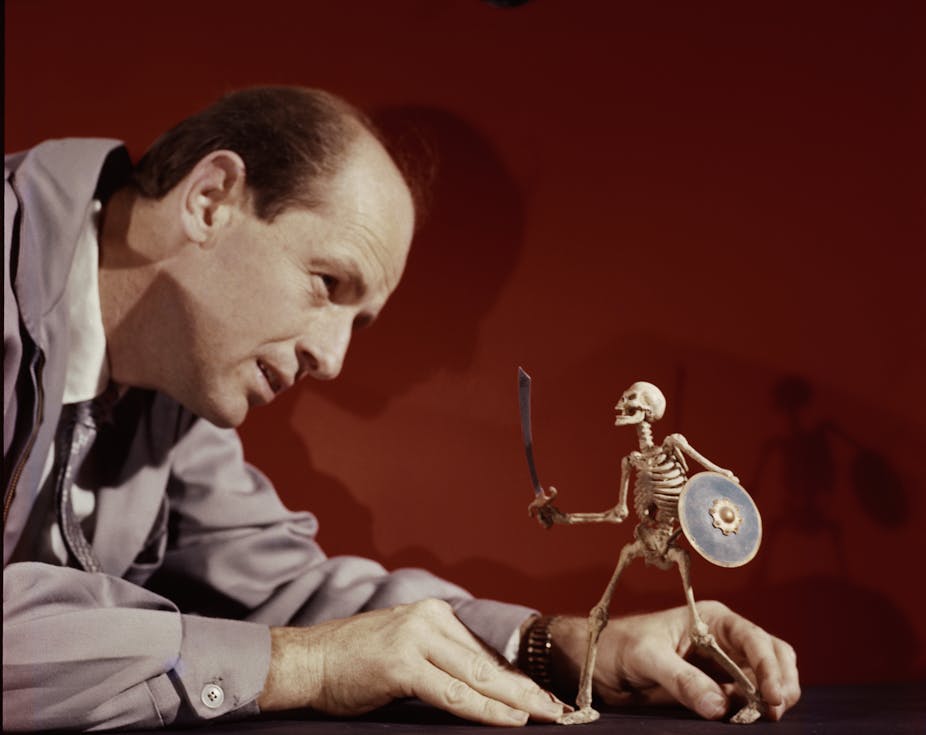It’s the early 1980s and I’m about ten years old. On the TV is a fantasy movie replete with swords and ships. And monsters: monsters of metal, monsters of bone. Creatures of the imagination. And they are all brought to life with frightening realism on the screen before me. Those creatures lit up my young mind. The movie was Jason And The Argonauts, which was my introduction to the wonderful world of animator and movie-maker, Ray Harryhausen.
Harryhausen was a pioneer of stop-motion animation, using models to bring special effects to science fiction and fantasy movies from the gorilla in Mighty Joe Young in 1949 to Pegasus, the flying horse, in Clash Of The Titans, 1981. From flying saucers to dinosaurs, real and extinct animals, with various monsters and mythical creatures in between, Ray brought a diversity of scenes and movies to life in ways that few contemporaries could match, all before CGI (computer-generated imagery), the go-to animation tool of today.
Creator of monsters
A plethora of modern-day special-effects maestros cite Harryhausen as an influence, including Steven Spielberg, George Lucas, Peter Jackson, and Guillermo del Toro. And Harryhausen is much beloved of a particular demographic, who grew up watching Harryhausen creatures on movie repeats on the TV. A demographic which might just include me.
Harryhausen also has a special place in the heart (and minds) of a number of zoologists, palaeontologists, and others with a scientific interest in biomechanics and comparative anatomy. For example, the pterosaur palaeontologist Mark Witton, zoologist and Tyrannosaurus expert Dave Hone and evolutionary biomechanist John Hutchison.
Read more: Dinosaur egg bonanza gives vital clues about prehistoric parenting
As an ecologist, I also belong to this set of fans and I use Harryhausen movies to illustrate “living, breathing, moving” reconstructions of dinosaurs and pterosaurs to my students.

Harryhausen had great imagination but also had an eye and a brain for realism. He made animals interact with people on screen in ways impossible with real live animals. His rendering of the elephant in The Valley of Gwangi, the crab in Mysterious Island, and the baboon in Sinbad And The Eye Of The Tiger, are incredible in their realism.
He resurrected extinct creatures, including a sabre-toothed tiger and woolly mammoth. And yes, there were dinosaurs, and other extinct giant reptiles, including pterosaurs (one of which famously carried off a fur-bikini-clad Raquel Welch in One Million Years BC).
Read more: Why I jumped at the chance to bring the real T. rex to life for TV
In addition, Harryhausen created believable alien flying saucers, and all manner of monsters and creatures: the Cyclops, Medusa, the Kraken and the Children of Hydra’s Teeth (or skeleton army, one of the most iconic of cinema moments ever) to name a few.
Titan of cinema
Harryhausen had a studious attention to detail and an inordinate well of patience. It took him four and a half months to animate the skeleton fight sequence in Jason And The Argonauts, which plays out in just four and a half minutes in real-time in the movie.
So, Harryhausen did what modern anatomists do, in endeavouring to understand how the bodies of animals work (in terms of bones, muscle, and other soft tissues). He took this understanding into re-imagining extinct creatures, much as palaeontologists do today. He did so endeavouring to recreate, not just what a dinosaur (or other extinct creatures) looked like, but how it moved, what sounds it made, and how it interacted with its environment and other organisms within it.
Whilst Harryhausen is best known for his 3D models that, despite their diminutive size, often overshadowed and outshone the human actors on-screen in the science-fiction and fantasy movies he created, he also produced storyboard sketches and key drawings to sell his ideas of stories and scenes to movie studios.
Stylistically, Harryhausen’s 2D conceptual art was inspired by artists including illustrator Gustave Dore, architect and painter Joseph Gandy and the wildlife painter and palaeoartist Charles Knight. His framing, composition, and anatomical detail reflect these influences. His inspiration for mannequin-making came from Willis O’Brien, who created the original King Kong. Harryhausen went to see O’Brien’s 1933 King Kong movie 33 times at his local cinema.
Read more: The science of anatomy is undergoing a revival
Harryhausen was one of the earliest filmmakers to bring extinct (as well as imagined) creatures to life on the screen. He therefore bridged science and the arts, inspiring future scientists as well as the next generation of filmmakers. This pioneering approach to cinema is currently being celebrated at The Scottish National Gallery of Modern Art (National Galleries of Scotland) in Ray Harryhausen: Titan Of Cinema.
So, it’s 2020, the centenary year of the birth of Harryhausen. On TV there is a fantasy movie replete with swords and ships and monsters. The movie is Jason And The Argonauts. And, as an ecologist with an interest in behavioural ecology, biomechanics, and palaeontology, I am as fired with inspiration and wonder as when I was ten, by the skill of the pioneering art of this titan of cinema.

